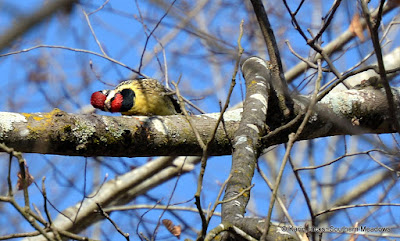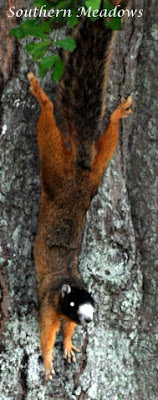Yellow-bellied Sapsuckers and their Feeding Holes
The only completely migratory woodpecker in the Eastern U.S., the yellow-bellied sapsucker (Sphyrapicus varius), is one of my favorite winter visitors to our woods. I've written about them before, which you can read here. But, today I'm focusing on their feeding holes.
This fairly shy bird is more often heard than seen, but a walk through our forest reveals all the signs of its presence. Rings of closely spaced holes band trees, especially the maples and hickories. These holes are often mistaken for insect damage; however, insect damage will have fewer, smaller holes that are more randomly placed. This tree has been a repeat customer for these industrious woodpeckers.
Sapsuckers bore two types of holes into trees. Round holes extend deep into the xylem, where the sapsuckers lick up sap that is moving up into the branches.
After the trees leaf out, shallow, square holes, that penetrate the phloem, ooze sap that they lap up with their short brushy tongues. These shallow holes must continually be maintained for sap to flow.
Phloem tree sap has a similar content to flower nectar. Other animals, who like this free-flowing sap are also attracted to these holes such as chipmunks, bats, hummingbirds, orioles, warblers, nuthatches and butterflies. Conversely, in early spring you may see yellow-bellied sapsuckers visiting your hummingbird or oriole nectar feeders.
New holes are made in the same, horizontal line as older holes or a new line directly above the old one. This makes for an unmistakable pattern.
This tree has been a favorite of this male sapsucker this winter. See how well he blends in with the bark. His mottled feathers against the tree trunk look like shadows and dappled sunlight. It is only when he lifts his head revealing a flashy bright red head or when he clings to the side of the trunk that he is more noticeable. Of course the drilling will give him away every time.
Sapsuckers will use many species of trees and woody plants, but they prefer trees with higher sugar content such as paper/yellow birch, hickory and sugar/red maple. They are often seen in the Southeast in hickory/pine/oak forests.
The main source of food for yellow-bellied sapsuckers, however, isn't sap, but insects such as beetles, ants, moths and dragonflies. However, when they visit our garden during the winter months, insects are not always readily available. They will eat fruit and berries if they can find them and when those are scarce they go for the sap.
Not everyone appreciates these active birds, but I enjoy having them around. It is relatively rare for a tree to die from numerous rows of wells. I have yet to see it happen in our woods and we have many that are decorated with their artistic drilling. Besides, the death of a tree is part of the dynamic nature of woodland habitats.
These vibrant woodpeckers will be leaving us in spring to make their journey to their breeding ground in the northern U.S. and Canada. Hummingbirds often follow their migration using sapsucker holes as a source of nectar and protein when blooms are sparse.
 |
| Male yellow-bellied sapsucker taking a quick peek at what I'm doing |
This fairly shy bird is more often heard than seen, but a walk through our forest reveals all the signs of its presence. Rings of closely spaced holes band trees, especially the maples and hickories. These holes are often mistaken for insect damage; however, insect damage will have fewer, smaller holes that are more randomly placed. This tree has been a repeat customer for these industrious woodpeckers.
Sapsuckers bore two types of holes into trees. Round holes extend deep into the xylem, where the sapsuckers lick up sap that is moving up into the branches.
 |
| yellow-bellied sapsucker sapwells |
After the trees leaf out, shallow, square holes, that penetrate the phloem, ooze sap that they lap up with their short brushy tongues. These shallow holes must continually be maintained for sap to flow.
 | |
| a close look at the holes created by sapsuckers |
Phloem tree sap has a similar content to flower nectar. Other animals, who like this free-flowing sap are also attracted to these holes such as chipmunks, bats, hummingbirds, orioles, warblers, nuthatches and butterflies. Conversely, in early spring you may see yellow-bellied sapsuckers visiting your hummingbird or oriole nectar feeders.
New holes are made in the same, horizontal line as older holes or a new line directly above the old one. This makes for an unmistakable pattern.
This tree has been a favorite of this male sapsucker this winter. See how well he blends in with the bark. His mottled feathers against the tree trunk look like shadows and dappled sunlight. It is only when he lifts his head revealing a flashy bright red head or when he clings to the side of the trunk that he is more noticeable. Of course the drilling will give him away every time.
Sapsuckers will use many species of trees and woody plants, but they prefer trees with higher sugar content such as paper/yellow birch, hickory and sugar/red maple. They are often seen in the Southeast in hickory/pine/oak forests.
The main source of food for yellow-bellied sapsuckers, however, isn't sap, but insects such as beetles, ants, moths and dragonflies. However, when they visit our garden during the winter months, insects are not always readily available. They will eat fruit and berries if they can find them and when those are scarce they go for the sap.
Not everyone appreciates these active birds, but I enjoy having them around. It is relatively rare for a tree to die from numerous rows of wells. I have yet to see it happen in our woods and we have many that are decorated with their artistic drilling. Besides, the death of a tree is part of the dynamic nature of woodland habitats.
These vibrant woodpeckers will be leaving us in spring to make their journey to their breeding ground in the northern U.S. and Canada. Hummingbirds often follow their migration using sapsucker holes as a source of nectar and protein when blooms are sparse.






.png)
